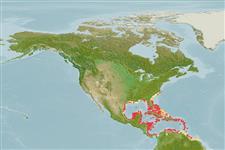>
Gobiiformes (Gobies) >
Gobiidae (Gobies) > Gobiinae
Etymology: Risor: Latin, risor, -oris = clownish.
Environment: milieu / climate zone / depth range / distribution range
Ökologie
seewasser riff-verbunden. Tropical; - 6°N
Western Atlantic: southern Florida, USA and the Bahamas to northeastern Brazil (Ref. 39606).
Size / Gewicht / Alter
Maturity: Lm ? range ? - ? cm
Max length : 2.5 cm TL Männchen/unbestimmt; (Ref. 7251)
Rückenflossenstacheln (insgesamt): 7; Rückenflossenweichstrahlen (insgesamt): 112; Afterflossenstacheln 1; Afterflossenweichstrahlen: 9 - 10. Distinguished by the following characteristics: first dorsal fin spines VII; completely united pelvic fins; scales only on posterior section of the trunk; four modified basicaudal scales at the base of the caudal fin; light to dark brown body color with faint internal bars visible on lighter specimens; 2-4 enlarged re-curved canines in each jaw that project out of the mouth, point out and up in the upper jaw, down and back on the lower jaw (Ref. 92840).
Found in association with large barrel sponges, generally along outside hiding in crevices, also sometimes within the sponge tubules (Ref. 92840).
Life cycle and mating behavior
Geschlechtsreife | Fortpflanzung | Ablaichen | Eier | Fecundity | Larven
Robins, C.R. and G.C. Ray, 1986. A field guide to Atlantic coast fishes of North America. Houghton Mifflin Company, Boston, U.S.A. 354 p. (Ref. 7251)
IUCN Rote Liste Status (Ref. 130435)
Bedrohung für Menschen
Harmless
Nutzung durch Menschen
Mehr Information
NamenSynonymeMetabolismusRäuberÖkotoxikologieFortpflanzungGeschlechtsreifeAblaichenSpawning aggregationFecundityEierEientwicklung
ReferenzenAquakulturAquakultur ProfilZuchtlinienGenetikElectrophoresesVererbbarkeitKrankheitenVerarbeitungNutrientsMass conversion
Tools
Zusatzinformationen
Download XML
Internet Quellen
Estimates based on models
Preferred temperature (Ref.
123201): 24.4 - 28.2, mean 27.3 °C (based on 599 cells).
Phylogenetic diversity index (Ref.
82804): PD
50 = 1.0000 [Uniqueness, from 0.5 = low to 2.0 = high].
Bayesian length-weight: a=0.01023 (0.00477 - 0.02194), b=3.02 (2.84 - 3.20), in cm total length, based on LWR estimates for this (Sub)family-body shape (Ref.
93245).
Trophic level (Ref.
69278): 3.0 ±0.3 se; based on size and trophs of closest relatives
Widerstandsfähigkeit (Ref.
120179): hoch, Verdopplung der Population dauert weniger als 15 Monate. (Preliminary K or Fecundity.).
Fishing Vulnerability (Ref.
59153): Low vulnerability (10 of 100).
Nutrients (Ref.
124155): Calcium = 380 [164, 1,300] mg/100g; Iron = 1.9 [0.8, 4.2] mg/100g; Protein = 18.1 [15.9, 20.0] %; Omega3 = 0.173 [0.054, 0.544] g/100g; Selenium = 39.5 [11.6, 111.7] μg/100g; VitaminA = 92.7 [17.8, 468.6] μg/100g; Zinc = 4.63 [2.46, 7.75] mg/100g (wet weight);
